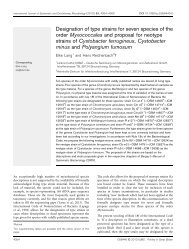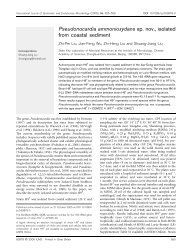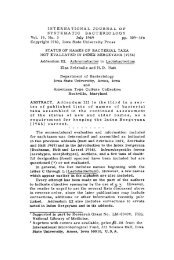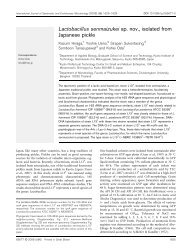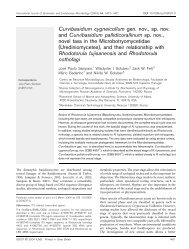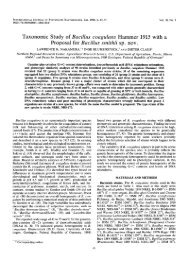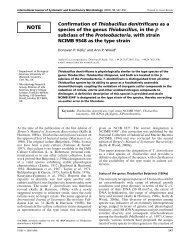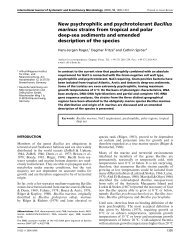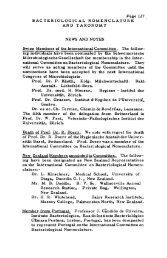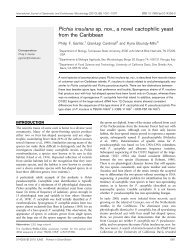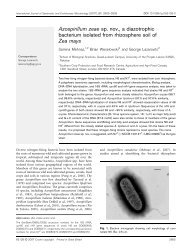A proposal for the reclassification of Bdellovibrio stolpii and ...
A proposal for the reclassification of Bdellovibrio stolpii and ...
A proposal for the reclassification of Bdellovibrio stolpii and ...
You also want an ePaper? Increase the reach of your titles
YUMPU automatically turns print PDFs into web optimized ePapers that Google loves.
International Journal <strong>of</strong> Systematic <strong>and</strong> Evolutionary Microbiology (2000), 50, 219–224<br />
Printed in Great Britain<br />
A <strong>proposal</strong> <strong>for</strong> <strong>the</strong> <strong>reclassification</strong> <strong>of</strong><br />
<strong>Bdellovibrio</strong> <strong>stolpii</strong> <strong>and</strong> <strong>Bdellovibrio</strong> starrii into<br />
a new genus, Bacteriovorax gen. nov. as<br />
Bacteriovorax <strong>stolpii</strong> comb. nov. <strong>and</strong><br />
Bacteriovorax starrii comb. nov., respectively<br />
Marcie L. Baer, 1 † Jacques Ravel, 2 ‡ Jongsik Chun, 2 § Russell T. Hill 2<br />
<strong>and</strong> Henry N. Williams 1<br />
Author <strong>for</strong> correspondence: Marcie L. Baer. Tel: 1 205 348 1820. Fax: 1 205 348 1786.<br />
e-mail: mbaerbiology.as.ua.edu<br />
1 Department <strong>of</strong> Oral <strong>and</strong><br />
Crani<strong>of</strong>acial Biological<br />
Sciences, University <strong>of</strong><br />
Maryl<strong>and</strong> at Baltimore,<br />
666 W. Baltimore Street,<br />
Baltimore, MD 21201, USA<br />
2 Center <strong>of</strong> Marine<br />
Biotechnology, University<br />
<strong>of</strong> Maryl<strong>and</strong><br />
Biotechnology Institute,<br />
701 East Pratt Street,<br />
Baltimore, MD 21201, USA<br />
<strong>Bdellovibrio</strong>s are unique bacteria with <strong>the</strong> ability to prey upon a wide variety<br />
<strong>of</strong> susceptible Gram-negative bacteria. Micro-organisms exhibiting this trait<br />
have been included in <strong>the</strong> genus <strong>Bdellovibrio</strong> despite <strong>the</strong>ir isolation from<br />
diverse habitats <strong>and</strong> relatively unstudied taxonomic relatedness. In this study,<br />
16S rDNA sequences were compared from known terrestrial <strong>Bdellovibrio</strong><br />
species, <strong>Bdellovibrio</strong> bacteriovorus 100 T , <strong>Bdellovibrio</strong> <strong>stolpii</strong> Uki2 T <strong>and</strong><br />
<strong>Bdellovibrio</strong> starrii A3.12 T in order to study <strong>the</strong>ir phylogenetic relationship. The<br />
two sequences from B. <strong>stolpii</strong> Uki2 T <strong>and</strong> B. starrii A3.12 T were 900% similar to<br />
each o<strong>the</strong>r but exhibited only 817% <strong>and</strong> 812% similarity, respectively to B.<br />
bacteriovorus 100 T . Phylogenetic analysis indicated that B. bacteriovorus 100 T<br />
clustered in a separate clade from B. starrii A3.12 T <strong>and</strong> B. <strong>stolpii</strong> Uki2 T ,<br />
demonstrating only a distant relationship between B. bacteriovorus 100 T <strong>and</strong><br />
<strong>the</strong> o<strong>the</strong>r two recognized type species. DNA–DNA hybridization experiments<br />
also demonstrated 4% hybridization between <strong>the</strong>se three species. On <strong>the</strong><br />
basis <strong>of</strong> <strong>the</strong> results obtained from <strong>the</strong> phylogenetic analysis <strong>and</strong> DNA–DNA<br />
hybridization studies, it is proposed that B. <strong>stolpii</strong> Uki2 T <strong>and</strong> B. starrii A3.12 T<br />
should be transferred to a new genus, Bacteriovorax gen. nov. as<br />
Bacteriovorax <strong>stolpii</strong> comb. nov. <strong>and</strong> Bacteriovorax starrii comb. nov.,<br />
respectively. It is also proposed that <strong>the</strong> type species <strong>for</strong> <strong>the</strong> new genus<br />
Bacteriovorax should be Bacteriovorax <strong>stolpii</strong> comb. nov.<br />
Keywords: <strong>Bdellovibrio</strong>, taxonomy, 16S rDNA<br />
INTRODUCTION<br />
<strong>Bdellovibrio</strong>s are unique, obligately predatory bacteria<br />
that prey upon a wide variety <strong>of</strong> susceptible Gram-<br />
.................................................................................................................................................<br />
† Present address: The University <strong>of</strong> Alabama, Department <strong>of</strong> Biological<br />
Sciences, Box 870344, Tuscaloosa, AL 35487, USA.<br />
‡ Present address: The Johns Hopkins University, Chemistry Department,<br />
235 Remsen Hall/3400 N. Charles St, Baltimore, MD 21218, USA.<br />
§ Present address: Korean Collection <strong>for</strong> Type Cultures, Korea Research<br />
Institute <strong>of</strong> Bioscience <strong>and</strong> Biotechnology, Yusong, Taejon 305-600, Republic<br />
<strong>of</strong> Korea.<br />
Abbreviation : PI, prey-independent.<br />
The EMBL accession numbers <strong>for</strong> <strong>the</strong> 16S rDNA sequences <strong>of</strong> <strong>Bdellovibrio</strong><br />
bacteriovorus 100 T <strong>and</strong> Bacteriovorax starrii are AF084850 <strong>and</strong> AF084852,<br />
respectively.<br />
negative micro-organisms. Wild-type bdellovibrios<br />
must be cultivated in mixed culture with <strong>the</strong>ir prey.<br />
This poses a real challenge to conventional characterization<br />
which relies on growth <strong>of</strong> <strong>the</strong> organisms in<br />
pure culture <strong>for</strong> taxonomic analysis. The isolation <strong>of</strong><br />
prey-independent (PI) mutant strains <strong>of</strong> <strong>Bdellovibrio</strong><br />
which can be grown in pure culture circumvents <strong>the</strong><br />
difficulties <strong>of</strong> studying <strong>the</strong> organisms in dual culture.<br />
Ribotype <strong>and</strong> 16S rDNA sequence similarity studies in<br />
our laboratory (Baer et al., 1998) as well as phage<br />
susceptibility studies (Varon & Levisohn, 1972) comparing<br />
wild-type strains to <strong>the</strong>ir equivalent mutant<br />
strains have revealed no differences between <strong>the</strong> <strong>for</strong>ms.<br />
In <strong>the</strong> past, predatory bacteria exhibiting <strong>the</strong> typical<br />
intraperiplasmic cell cycle described by Starr & Baigent<br />
01105 2000 IUMS 219
M. L. Baer <strong>and</strong> o<strong>the</strong>rs<br />
(1966) were included in <strong>the</strong> genus <strong>Bdellovibrio</strong> without<br />
consideration <strong>of</strong> <strong>the</strong>ir genetic relationship <strong>and</strong> despite<br />
large differences in GC ratios (6–10 mol% <strong>and</strong> in<br />
some cases, as high as 15 mol%) (Burnham & Conti,<br />
1984; Seidler et al., 1972).<br />
Results from early molecular studies <strong>of</strong> different<br />
<strong>Bdellovibrio</strong> strains, including <strong>Bdellovibrio</strong> bacteriovorus<br />
100T, <strong>Bdellovibrio</strong> <strong>stolpii</strong> Uki2T <strong>and</strong> <strong>Bdellovibrio</strong><br />
starrii A3.12T, suggested that bdellovibrios are a<br />
phylogenetically heterogeneous group <strong>of</strong> microorganisms<br />
(Donze et al., 1991; Hespell et al., 1984;<br />
Oyaizu & Woese, 1985; Stackebr<strong>and</strong>t, 1988; Woese,<br />
1987). Previous studies revealed variations in GC<br />
content (mol%) <strong>and</strong> low DNA–DNA hybridization<br />
between strains with different GC ratios (Seidler et<br />
al., 1972). O<strong>the</strong>r studies <strong>of</strong> <strong>Bdellovibrio</strong> species have<br />
demonstrated low similarity values between partial<br />
16S rRNA sequences (Donze et al., 1991) as well as<br />
substantially different restriction enzyme pr<strong>of</strong>iles (Baer<br />
et al., 1998; Scognamiglio & Tudor, 1996). High levels<br />
<strong>of</strong> diversity among <strong>Bdellovibrio</strong> species has also been<br />
demonstrated using physiological <strong>and</strong> cultural characteristics<br />
such as fatty acid composition (Gue<strong>the</strong>r et al.,<br />
1993), antibiotic resistance patterns (Gue<strong>the</strong>r &<br />
Williams, 1993) <strong>and</strong> enzymic activities (H. N.<br />
Williams, unpublished data). An analysis <strong>of</strong> serological<br />
properties (Schelling et al., 1977), phage typing<br />
<strong>and</strong> physiological properties <strong>of</strong> <strong>the</strong> organisms has<br />
revealed that all three recognized species (B. bacteriovorus<br />
100T, B. <strong>stolpii</strong> Uki2T <strong>and</strong> B. starrii A3.12T) <strong>for</strong>m<br />
distinct groups (Althauser et al., 1972; Hashimoto et<br />
al., 1970; Varon & Levisohn, 1972).<br />
The collective results from <strong>the</strong>se studies demonstrate<br />
that <strong>the</strong> use <strong>of</strong> predatory behaviour as <strong>the</strong> sole defining<br />
property <strong>for</strong> placing organisms within <strong>the</strong> <strong>Bdellovibrio</strong><br />
genus has resulted in a collection <strong>of</strong> molecularly diverse<br />
organisms <strong>and</strong> suggests a taxonomic separation <strong>of</strong> B.<br />
<strong>stolpii</strong> Uki2T <strong>and</strong> B. starrii A3.12T from <strong>the</strong> <strong>Bdellovibrio</strong><br />
bacteriovorus group. This suggestion is proposed<br />
by <strong>the</strong> authors <strong>of</strong> Bergey’s Manual <strong>of</strong> Systematic<br />
Bacteriology (Burnham & Conti, 1984). The authors<br />
stated that <strong>the</strong> diversity <strong>of</strong> <strong>the</strong> members assigned to <strong>the</strong><br />
genus <strong>Bdellovibrio</strong> ‘places considerable stress upon <strong>the</strong><br />
concept <strong>of</strong> a single genus …’. However, <strong>the</strong>y chose not<br />
to propose changes at that time perhaps due to gaps in<br />
<strong>the</strong> in<strong>for</strong>mation needed to substantiate <strong>the</strong> argument<br />
<strong>for</strong> change. New molecular methods are now available<br />
<strong>and</strong> in wide use to obtain <strong>the</strong> needed in<strong>for</strong>mation to fill<br />
<strong>the</strong> gaps in <strong>the</strong> nucleic acid composition <strong>of</strong> <strong>the</strong>se<br />
micro-organisms.<br />
The comparison <strong>of</strong> rDNA sequences has become a<br />
powerful evolutionary tool <strong>for</strong> determining phylogenetic<br />
relationships (Weisburg et al., 1991). Woese<br />
(1987) proposed that rDNA sequences provide <strong>the</strong><br />
most useful <strong>and</strong> stable ‘molecular clock’ <strong>for</strong> phylogenetic<br />
analyses. These sequences are found in all<br />
organisms <strong>and</strong> can be sequenced directly through<br />
application <strong>of</strong> PCR (Saiki et al., 1988).<br />
In <strong>the</strong> present investigation, complete 16S rDNA<br />
sequences from three <strong>Bdellovibrio</strong> sp., B. bacteriovorus<br />
100T, B. <strong>stolpii</strong> Uki2T <strong>and</strong> B. starrii A3.12T, were<br />
compared in order to clarify <strong>the</strong>ir taxonomic relationship.<br />
DNA–DNA hybridization studies were used as a<br />
complementary means to analyse <strong>the</strong> phylogenetic<br />
relationships between <strong>the</strong> three species.<br />
METHODS<br />
Bacterial strains <strong>and</strong> culture conditions. The saprophyticPI<br />
strains used in this study were B. bacteriovorus strain 100T<br />
( ATCC 25622T), B. <strong>stolpii</strong> Uki2T ( ATCC 27052T), B.<br />
starrii A3.12T ( ATCC 15145T), B. bacteriovorus Ox9-2<br />
( ATCC 25630), B. bacteriovorus E( ATCC 25634), B.<br />
bacteriovorus 2484Se2 ( ATCC 25635). PI strain B. bacteriovorus<br />
109J was obtained from M. Thomashaw,<br />
Michigan State University, East Lansing, MI, USA. All PI<br />
strains were maintained on peptoneyeast extract media<br />
(1% Bacto-peptone; 03% yeast extract <strong>and</strong> 15% Bactoagar)<br />
at 25 C by weekly transfer (Seidler & Starr, 1969).<br />
Genomic DNA extraction. In preparation <strong>for</strong> DNA extraction,<br />
cells were harvested by centrifugation (3000 g) <strong>for</strong><br />
10 min, <strong>the</strong> pellets were resuspended in a 5 ml total volume<br />
<strong>of</strong> TE buffer (10 mM Tris, 1 mM EDTA, pH 80) containing<br />
a final lysozyme (Sigma) concentration <strong>of</strong> 2 mg ml−.<br />
Samples were incubated at 30 C <strong>for</strong> 30 min. Following <strong>the</strong><br />
lysozyme step, genomic DNA was extracted using <strong>the</strong> CTAB<br />
procedure (Ausubel et al., 1987). Phase Lock Gel II B Heavy<br />
(5 Prime 3 Prime) was incorporated into <strong>the</strong> phenol:chloro<strong>for</strong>m:isoamyl<br />
alcohol extraction to ensure complete separation<br />
<strong>of</strong> <strong>the</strong> aqueous phase from any contaminating<br />
protein. Samples were treated with 1 µl RNase, DNase-free<br />
(500 mg ml−) (Boehringer Mannheim) <strong>for</strong> 30 min followed<br />
by a second phenol:chloro<strong>for</strong>m:isoamyl alcohol extraction.<br />
DNA was precipitated by <strong>the</strong> addition <strong>of</strong> 06 vol. 2-propanol,<br />
<strong>the</strong> pellet was washed with 70% ethanol <strong>and</strong> resuspended in<br />
TE. DNA was quantified by absorption spectrophotometry<br />
at A (Beckman Instruments).<br />
<br />
Amplification <strong>and</strong> sequencing <strong>of</strong> 16S rDNA. The 16S rDNA<br />
from B. bacteriovorus 100T <strong>and</strong> B. starrii A3.12T was<br />
amplified from total chromosomal DNA prepared as described<br />
above using PCR. rDNA-targeted oligonucleotide<br />
primers specific <strong>for</strong> eubacterial 16S rRNA genes [<strong>for</strong>ward<br />
primer 8-27, 5-AGAGTTTGATCCTGGCTCAG-3<br />
(modified from FD1) (Weisburg et al., 1991); reverse primer<br />
1492, 5-GGTTACCTTGTTACGACTT-3 (Reysenbach et<br />
al., 1992; Weisburg et al., 1991) were used in <strong>the</strong> PCR<br />
reaction. PCR fragments were gel-purified <strong>and</strong> sequenced<br />
using a Perkin Elmer Dye Terminator Cycle Sequencing<br />
Ready Reaction kit with fluorescent terminators <strong>and</strong> primers<br />
used <strong>for</strong> PCR amplification. Reactions were run on an ABI<br />
373A sequencing instrument (Applied Biosystems). Initial<br />
sequences generated by <strong>the</strong> universal primers were aligned<br />
using <strong>the</strong> PILEUP function <strong>of</strong> <strong>the</strong> GCG Wisconsin Package<br />
(v.9, Genetics Computer Group); <strong>the</strong>se aligned sequences<br />
were <strong>the</strong>n used to construct <strong>Bdellovibrio</strong>-specific primers.<br />
This method was repeated with each new section <strong>of</strong> sequence<br />
until <strong>the</strong> entire 16S rDNA sequence was completed. Doublestr<strong>and</strong>ed<br />
sequencing <strong>of</strong> <strong>the</strong> <strong>Bdellovibrio</strong> 16S rRNA gene was<br />
done to ensure accuracy <strong>of</strong> <strong>the</strong> sequences.<br />
Phylogenetic analysis. Complete <strong>Bdellovibrio</strong> 16S rDNA<br />
sequences were aligned with <strong>the</strong> PHYDIT program (Chun,<br />
1995) along with o<strong>the</strong>r closely related micro-organisms.<br />
Alignments were used to identify hypervariable regions<br />
220 International Journal <strong>of</strong> Systematic <strong>and</strong> Evolutionary Microbiology 50
Reclassification <strong>of</strong> <strong>the</strong> genus <strong>Bdellovibrio</strong><br />
within <strong>the</strong> different sequences <strong>and</strong> <strong>the</strong>se regions were<br />
excluded from <strong>the</strong> phylogenetic analyses, resulting in a total<br />
<strong>of</strong> 1236 nt sites used in <strong>the</strong> analyses. Evolutionary trees were<br />
inferred by using four treeing algorithms, namely, <strong>the</strong><br />
Fitch–Margoliash (Fitch & Margoliash, 1967), maximumlikelihood<br />
(Felsenstein, 1981; Olsen et al., 1994), maximumparsimony<br />
(Kluge & Farris, 1969) <strong>and</strong> neighbour-joining<br />
(Saitou & Nei, 1987) methods. Evolutionary distance<br />
matrices <strong>for</strong> <strong>the</strong> neighbour-joining <strong>and</strong> Fitch–Margoliash<br />
methods were generated by <strong>the</strong> method <strong>of</strong> Jukes & Cantor<br />
(1969). The PHYLIP package (Felsenstein, 1993) was used <strong>for</strong><br />
<strong>the</strong> neighbour-joining, Fitch–Margoliash <strong>and</strong> maximumparsimony<br />
analyses while <strong>the</strong> FASTDNAML program (Olsen<br />
et al., 1994) was used <strong>for</strong> <strong>the</strong> maximum-likelihood method.<br />
The final rooted tree was evaluated by bootstrap analyses <strong>of</strong><br />
<strong>the</strong> neighbour-joining method based on 1000 resamplings.<br />
Purification <strong>of</strong> genomic DNA <strong>for</strong> DNA–DNA hybridization<br />
studies. CsCl density gradients were prepared according to<br />
<strong>the</strong> procedure described by Ausubel (1987). The density<br />
gradients were centrifuged in a Beckman angle Ti70 rotor<br />
(Beckman Instruments) at 65000 r.p.m. <strong>for</strong> 16 h followed by<br />
50000 r.p.m. <strong>for</strong> 2 h at 20 C. B<strong>and</strong>s were collected <strong>and</strong> <strong>the</strong><br />
ethidium bromide was removed from <strong>the</strong> samples using a<br />
saturated 2-propanolNaCl solution (Maniatis, 1982).<br />
Samples were resuspended in TE <strong>and</strong> quantified by UV<br />
spectrophotometry (Beckman Instruments).<br />
Membrane preparation <strong>and</strong> DNA labelling. DNA hybridization<br />
values were determined using a direct binding assay<br />
(Johnson, 1988). The DNA samples were heated to 95 C<br />
<strong>and</strong> quickly cooled on ice followed by <strong>the</strong> addition <strong>of</strong> one<br />
volume <strong>of</strong> 20 SSC to each sample. Ei<strong>the</strong>r 1 µg or 500 ng <strong>of</strong><br />
each sample was vacuum blotted onto Hybond-N nylon<br />
membranes (Amersham Life Sciences). Target DNA was<br />
denatured by soaking <strong>the</strong> membranes in a solution containing<br />
15 M NaCl <strong>and</strong> 05 M NaOH <strong>for</strong> 5 min; this was<br />
followed by a neutralization step in a solution containing<br />
15 M NaCl, 05 M TrisHCl (pH 72) <strong>and</strong> 0001 M EDTA<br />
<strong>for</strong> 1 min. Membranes were allowed to air dry <strong>and</strong> <strong>the</strong> DNA<br />
was fixed by UV cross-linking. A total <strong>of</strong> 1 µg genomic DNA<br />
from each <strong>Bdellovibrio</strong> strain was labelled with [α-P] dCTP<br />
by r<strong>and</strong>om priming using Ready-To-Go DNA labelling<br />
beads (Pharmacia Biotech). Subsequently, labelled genomic<br />
DNA from each strain was purified with a Sephadex G-25<br />
column (Maniatis et al., 1982).<br />
Hybridization. Membranes were prehybridized in a solution<br />
containing 6 SSC, 5 Denhardt’s solution, 05% (wv)<br />
SDS <strong>and</strong> 50 µg denatured salmon sperm DNA ml− (Sigma)<br />
according to <strong>the</strong> manufacturer’s protocol (HYBOND;<br />
Amersham). Labelled genomic DNA (210 c.p.m. ml−)<br />
was added to <strong>the</strong> prehybridization solution <strong>and</strong> <strong>the</strong> membranes<br />
were hybridized <strong>for</strong> 12 h at 65 C. Membranes were<br />
washed twice each in 2 SSC01% (wv) SDS <strong>for</strong> 15 min<br />
at room temperature. Membranes were exposed to a<br />
PhosphoImager screen (Eastman Kodak), <strong>the</strong> images were<br />
digitized with <strong>the</strong> STORM 840 PhosphoImager (Molecular<br />
Dynamics) <strong>and</strong> hybridization signals <strong>of</strong> <strong>the</strong> target dots were<br />
analysed quantitatively with <strong>the</strong> computer s<strong>of</strong>tware program<br />
IMAGEQUANT v.1.0 (Molecular Dynamics). Complete (100%)<br />
hybridization was defined as <strong>the</strong> intensity observed when <strong>the</strong><br />
labelled genomic DNA hybridized to itself.<br />
RESULTS AND DISCUSSION<br />
Previous studies using partial 16S rRNA sequencing,<br />
DNA hybridization studies <strong>and</strong> GC content have<br />
resulted in <strong>the</strong> classification <strong>of</strong> B. bacteriovorus 100T,<br />
B. <strong>stolpii</strong> Uki2T <strong>and</strong> B. starrii A3.12T as separate<br />
species within <strong>the</strong> same genus. In this study, complete<br />
16S rDNA sequences were analysed from each <strong>of</strong> <strong>the</strong>se<br />
strains to determine <strong>the</strong>ir evolutionary relationship. A<br />
similarity analysis comparing <strong>the</strong> 16S rDNA sequences<br />
from <strong>the</strong> three taxonomically recognized <strong>Bdellovibrio</strong><br />
sp. to 16S rDNA sequences from o<strong>the</strong>r related taxa<br />
within <strong>the</strong> delta division <strong>of</strong> <strong>the</strong> Proteobacteria was<br />
per<strong>for</strong>med. After a comparison <strong>of</strong> 1231 nt sites, <strong>the</strong><br />
level <strong>of</strong> similarity between different B. bacteriovorus<br />
strains used in this study (100T, 109J <strong>and</strong> E) was found<br />
to be 995%. These data are supported by analysis<br />
<strong>of</strong> partial 16S rRNA sequences deposited in GenBank<br />
by Donze et al. (1991) which shows <strong>the</strong> level <strong>of</strong><br />
similarity between additional B. bacteriovorus strains<br />
(114, Ox9-2, Ox9-3, 6-5-S <strong>and</strong> 109D) to be 97%. In<br />
contrast, <strong>the</strong> similarity between B. bacteriovorus 100T<br />
<strong>and</strong> B. <strong>stolpii</strong> Uki2T was found to be only 817%,<br />
whereas <strong>the</strong> similarity between B. starrii A3.12T <strong>and</strong> B.<br />
bacteriovorus 100T was 812%. These similarity values<br />
were as low, <strong>and</strong> in some cases much lower, than <strong>the</strong><br />
values observed when B. bacteriovorus 100T was<br />
compared to o<strong>the</strong>r organisms that phylogenetically<br />
group in <strong>the</strong> same clade but are considered to be<br />
members <strong>of</strong> separate genera. Examples <strong>of</strong> similarity<br />
levels between B. bacteriovorus 100T <strong>and</strong> o<strong>the</strong>r<br />
members <strong>of</strong> <strong>the</strong> delta division are as follows: Desulfovibrio<br />
desulfuricans,813%;Myxococcus xanthus,<br />
823%; Geobacter metallireducens, 838%; Desulfomonile<br />
tiedjei, 842%; Desulfuromonas acetoxidans,<br />
835%; <strong>and</strong> Desulfuromusa kysingii, 834%. The percentage<br />
similarity between <strong>the</strong> rDNA sequences from<br />
B. <strong>stolpii</strong> Uki2T <strong>and</strong> B. starrii A3.12T was significantly<br />
higher (900%).<br />
Complete 16S rDNA sequences were obtained <strong>for</strong> <strong>the</strong><br />
PI <strong>Bdellovibrio</strong> strains B. bacteriovorus 100T <strong>and</strong> B.<br />
starrii A3.12T. Comparison <strong>of</strong> <strong>the</strong>se sequences with <strong>the</strong><br />
16S rDNA sequence <strong>for</strong> B. <strong>stolpii</strong> Uki2T (M34125)<br />
already deposited in <strong>the</strong> GenBank database revealed<br />
substantial sequence differences between all three<br />
species. B. bacteriovorus 100T was shown to have 224<br />
<strong>and</strong> 230 bp different from B. <strong>stolpii</strong> Uki2T <strong>and</strong> B.<br />
starrii A3.12T, respectively. Only 127 differences in <strong>the</strong><br />
nucleotide sequence were found when B. <strong>stolpii</strong> Uki2T<br />
<strong>and</strong> B. starrii A3.12T sequences were compared with<br />
each o<strong>the</strong>r. It is evident from <strong>the</strong> 16S rDNA sequence<br />
similarity values that B. bacteriovorus 100T, B. starrii<br />
A3.12T <strong>and</strong> B. <strong>stolpii</strong> Uki2T can be distinguished from<br />
one ano<strong>the</strong>r.<br />
The distant relationship between <strong>the</strong>se three <strong>Bdellovibrio</strong><br />
sp. is also apparent from <strong>the</strong> rooted evolutionary<br />
tree (Fig. 1) based on <strong>the</strong> Jukes–Cantor distance model<br />
<strong>and</strong> <strong>the</strong> neighbour-joining methods. B. bacteriovorus<br />
100T clustered more closely with members <strong>of</strong> <strong>the</strong><br />
Desulfomonile, Desulfuromonas, Myxococcus, Geobacter<br />
<strong>and</strong> Desulfuromusa genera. B. <strong>stolpii</strong> Uki2T <strong>and</strong><br />
B. starrii A3.12T clustered toge<strong>the</strong>r but outside <strong>of</strong> <strong>the</strong><br />
B. bacteriovorus 100T clade. The nucleotide sequence<br />
data were also examined with three o<strong>the</strong>r tree-making<br />
International Journal <strong>of</strong> Systematic <strong>and</strong> Evolutionary Microbiology 50 221
M. L. Baer <strong>and</strong> o<strong>the</strong>rs<br />
100<br />
50 f 75<br />
f<br />
m,f<br />
f 46<br />
86<br />
m,p,f<br />
99<br />
m,f,p<br />
0·1<br />
100<br />
99<br />
Desulfovibrio desulfuricans<br />
<strong>Bdellovibrio</strong> <strong>stolpii</strong><br />
<strong>Bdellovibrio</strong> starrii<br />
Myxococcus xanthus<br />
Desulfomonile tiedjei<br />
Geobacter metallireducens<br />
Desulfuromonas acetoxidans<br />
Desulfuromusa kysingii<br />
<strong>Bdellovibrio</strong> bacteriovorus 100 T<br />
.................................................................................................................................................<br />
Fig. 1. Neighbour-joining tree. Phylogenetic analysis was based<br />
on 16S rRNA gene sequences (1236 bp) <strong>of</strong> <strong>Bdellovibrio</strong> sp. <strong>and</strong><br />
closely related genera. m, f <strong>and</strong> p indicate branches that<br />
were also found using <strong>the</strong> FASTDNAML, Fitch–Margoliash <strong>and</strong><br />
maximum-parsimony algorithms, respectively. The numbers at<br />
<strong>the</strong> nodes represent percentages indicating <strong>the</strong> level <strong>of</strong><br />
bootstrap support based on a neighbour-joining analysis <strong>of</strong><br />
1000 resampled data sets. The tree was generated using<br />
Pasteurella aerogenes P-172-71 T (M75048) <strong>and</strong> Xanthomonas<br />
phasedi (C. R. Woese, unpublished results) as outgroups. 16S<br />
rRNA sequences from <strong>the</strong> following organisms were used to<br />
construct <strong>the</strong> tree (GenBank accession numbers are indicated in<br />
paren<strong>the</strong>ses): Desulfomonile tiedjei DCB-1 T (M26635);<br />
Geobacter metallireducens GS-15 T (L07834); Desulfuromonas<br />
acetoxidans 11070 (M26634); Desulfuromusa kysingii Kysw2 T<br />
(X79414); Myxococcus xanthus MD207 (M34114); <strong>and</strong><br />
Desulfovibrio desulfuricans ATCC 27774 (M34113).<br />
algorithms: maximum-parsimony, maximum-likelihood<br />
<strong>and</strong> Fitch–Margoliash methods. All three<br />
methods produced similar results to <strong>the</strong> neighbourjoining<br />
algorithm. It is clear from <strong>the</strong> 16S rDNA<br />
sequence data that B. bacteriovorus 100T belongs in a<br />
separate clade with only a distant relationship to <strong>the</strong><br />
o<strong>the</strong>r two <strong>Bdellovibrio</strong> species investigated in this<br />
study.<br />
Results <strong>of</strong> <strong>the</strong> DNA–DNA hybridization study are<br />
shown in Table 1. This Table shows <strong>the</strong> high degree <strong>of</strong><br />
hybridization (70–100%) observed between four <strong>of</strong><br />
<strong>the</strong> different strains <strong>of</strong> B. bacteriovorus (100T, 109J,<br />
Ox9-2 <strong>and</strong> E) tested in this study. A lower degree <strong>of</strong><br />
hybridization (32–55%) was found between B. bacteriovorus<br />
2484Se2 <strong>and</strong> <strong>the</strong> o<strong>the</strong>r four B. bacteriovorus<br />
strains tested. Very low hybridization values were also<br />
observed between B. bacteriovorus strains (100T as well<br />
as o<strong>the</strong>r strains 109J, Ox9-2, E <strong>and</strong> 2484Se2) <strong>and</strong> both<br />
B. <strong>stolpii</strong> Uki2T (3%) <strong>and</strong> B. starrii A3.12T (4%).<br />
Similar hybridization values were observed between B.<br />
<strong>stolpii</strong> Uki2T <strong>and</strong> B. starrii A3.12T (4%). Reciprocal<br />
hybridization yielded similar results. Fur<strong>the</strong>rmore,<br />
<strong>the</strong>se results are consistent with a previous report that<br />
demonstrated very little hybridization between B.<br />
bacteriovorus 100T <strong>and</strong> <strong>the</strong> o<strong>the</strong>r two species (1%<br />
hybridization with B. starrii A3.12T <strong>and</strong> no hybridization<br />
with B. <strong>stolpii</strong> Uki2T) (Seidler et al., 1972).<br />
Although <strong>the</strong>se investigators observed a slightly higher<br />
degree <strong>of</strong> hybridization (16%) between B. <strong>stolpii</strong> Uki2T<br />
<strong>and</strong> B. starrii A3.12T than was observed in <strong>the</strong> present<br />
study (40%), this was most likely due to <strong>the</strong> different<br />
methods employed.<br />
The present investigation provides fur<strong>the</strong>r evidence<br />
that <strong>the</strong> genus <strong>Bdellovibrio</strong> consists <strong>of</strong> molecularly<br />
diverse groups <strong>of</strong> micro-organisms, which are not<br />
closely related to each o<strong>the</strong>r. It is clear that use <strong>of</strong> <strong>the</strong><br />
predatory lifestyle as <strong>the</strong> sole criterion <strong>for</strong> classification<br />
<strong>of</strong> <strong>the</strong>se organisms has resulted in <strong>the</strong> inclusion <strong>of</strong><br />
phylogenetically diverse groups within <strong>the</strong> same genus.<br />
Based on <strong>the</strong> 16S rDNA sequence analysis <strong>and</strong> <strong>the</strong><br />
DNA–DNA hybridization results reported in this<br />
investigation, it is clear that <strong>the</strong> two species B. <strong>stolpii</strong><br />
Uki2T <strong>and</strong> B. starrii A3.12T belong in a separate genus<br />
within <strong>the</strong> evolutionary line that encompasses <strong>the</strong> delta<br />
division <strong>of</strong> <strong>the</strong> Proteobacteria. It is proposed, <strong>the</strong>re<strong>for</strong>e,<br />
that B. <strong>stolpii</strong> Uki2T <strong>and</strong> B. starrii A3.12T be<br />
reclassified into <strong>the</strong> new genus, Bacteriovorax gen.<br />
nov. as Bacteriovorax <strong>stolpii</strong> comb. nov. <strong>and</strong> Bacteriovorax<br />
starrii comb. nov., respectively.<br />
Nucleotide sequence accession numbers<br />
The EMBL accession numbers <strong>for</strong> <strong>the</strong> 16S rDNA<br />
sequences which were determined in this study are as<br />
follows: <strong>Bdellovibrio</strong> bacteriovorus 100T, AF084850;<br />
<strong>and</strong> Bacteriovorax starrii, AF084852. The 16S rRNA<br />
sequence from Bacteriovorax <strong>stolpii</strong> was previously<br />
deposited in GenBank by C. R. Woese under EMBL<br />
accession number M34125. The partial 16S sequences<br />
from o<strong>the</strong>r B. bacteriovorus strains used <strong>for</strong> comparison<br />
purposes in <strong>the</strong> similarity analysis were deposited<br />
previously in GenBank by Donze et al. (1991)<br />
under <strong>the</strong> following EMBL accession numbers: 109D<br />
(M61235); 114 (M61230); Ox9-2 (M61232); Ox9-3<br />
(M61233); <strong>and</strong> 6-5-S (M61237).<br />
Description <strong>of</strong> Bacteriovorax gen. nov.<br />
Bacteriovorax (Bac.te.ri.o.vorax. Gr. dim. n. baktron<br />
small rod; L. n. vorax devourer; bacteriovorax<br />
devourer <strong>of</strong> bacteria).<br />
Members <strong>of</strong> this genus exhibit a biphasic life cycle,<br />
with <strong>the</strong> potential <strong>of</strong> displaying an actively predacious<br />
<strong>for</strong>m as well as a PI, saprophytic <strong>for</strong>m capable <strong>of</strong><br />
growing on nutrient medium. Prey-dependent (wildtype)<br />
strains are comma-shaped rods, 05–14 µm in<br />
length which demonstrate a predatory lifestyle in <strong>the</strong><br />
presence <strong>of</strong> susceptible prey bacteria. The wild-type<br />
strains are motile by a single, polar flagellum. PI cells<br />
(mutants) are pleomorphic, demonstrating a range <strong>of</strong><br />
222 International Journal <strong>of</strong> Systematic <strong>and</strong> Evolutionary Microbiology 50
Reclassification <strong>of</strong> <strong>the</strong> genus <strong>Bdellovibrio</strong><br />
Table 1. DNA–DNA hybridization values<br />
.....................................................................................................................................................................................................................................<br />
DNA–DNA hybridization values were determined using a direct binding assay <strong>and</strong> represent <strong>the</strong><br />
DNA relatedness (%) found between different <strong>Bdellovibrio</strong> strains. Complete (1000%)<br />
hybridization corresponds to <strong>the</strong> intensity measured when labelled genomic DNA is hybridized to<br />
itself.<br />
Labelled strain B. bacteriovorus B. <strong>stolpii</strong><br />
Uki2 T<br />
100 T 109J Ox9-2 E 2484Se2<br />
B. starrii<br />
A3.12 T<br />
B. bacteriovorus 100T 1000 1000 722 960 448 26 44<br />
B. bacteriovorus 109J 1000 1000 882 910 321 31 20<br />
B. bacteriovorus Ox9-2 750 875 1000 921 526 21 37<br />
B. bacteriovorus E 945 894 885 1000 326 29 19<br />
B. bacteriovorus 2484Se2 417 352 547 364 1000 00 22<br />
B. <strong>stolpii</strong> Uki2T 28 22 25 23 00 1000 42<br />
B. starrii A3.12T 41 25 31 30 31 40 1000<br />
cell shapes from simple rods to long, tightly spiral<br />
shaped cells. The mutants are motile upon initial<br />
isolation, but lose <strong>the</strong>ir motility after repeated transfer<br />
on solid media. Gram-negative. Oxidase- <strong>and</strong> catalasepositive.<br />
Some PI mutants may demonstrate variable<br />
catalase activity as some strains have been shown to<br />
lose this ability upon repeated transfer. Obligately<br />
aerobic. The GC content <strong>for</strong> members <strong>of</strong> this genus<br />
is 410–435 mol%. This genus demonstrates little to<br />
no DNA–DNA hybridization (4%) with <strong>the</strong> <strong>Bdellovibrio</strong><br />
genus, although <strong>the</strong>y were previously considered<br />
to belong with <strong>the</strong> bdellovibrios. Comparisons <strong>of</strong> total<br />
genomic restriction digest patterns (PFGE) generated<br />
<strong>for</strong> B. <strong>stolpii</strong> Uki2T <strong>and</strong> B. starrii A3.12T demonstrate<br />
little similarity to <strong>the</strong> patterns produced by members <strong>of</strong><br />
<strong>the</strong> <strong>Bdellovibrio</strong> genus (Baer et al., 1998). Similar<br />
results have been observed when comparing arbitrarily<br />
primed amplification pr<strong>of</strong>iles (AP-PCR) (Baer et al.,<br />
1998). rDNA sequence analysis demonstrates that <strong>the</strong><br />
two species placed within this genus are more closely<br />
related to each o<strong>the</strong>r (90% rDNA sequence similarity)<br />
than to <strong>the</strong> o<strong>the</strong>r members <strong>of</strong> <strong>the</strong> delta division<br />
<strong>of</strong> <strong>the</strong> Proteobacteria (Desulfovibrio, Myxococcus,<br />
<strong>Bdellovibrio</strong>, Desulfomonile, Desulfuromusa, Desulfuromonas<br />
<strong>and</strong> Geobacter). Bacteriovorax <strong>stolpii</strong> comb.<br />
nov. has been designated <strong>the</strong> type species <strong>for</strong> this<br />
genus.<br />
Description <strong>of</strong> Bacteriovorax <strong>stolpii</strong> comb. nov.<br />
Bacteriovorax <strong>stolpii</strong> (stolpi.i. M.L. gen. masc. n.<br />
<strong>stolpii</strong> <strong>of</strong> Stolp, named after <strong>the</strong> German microbiologist<br />
Heinz Stolp).<br />
The description <strong>of</strong> Bacteriovorax <strong>stolpii</strong> comb. nov.<br />
below is based on <strong>the</strong> original description by Seidler et<br />
al. (1972) <strong>and</strong> our own data. Strain Uki2T is <strong>the</strong> only<br />
isolate described at this time <strong>and</strong> is <strong>the</strong> type strain <strong>of</strong><br />
Bacteriovorax <strong>stolpii</strong> comb. nov. This isolate has a<br />
GC content <strong>of</strong> 418 mol% (Seidler et al., 1972). The<br />
optimal temperature range <strong>for</strong> growth <strong>of</strong> this organism<br />
is 15–35 C. The major cellular fatty acids are 15:1ω8c,<br />
13:0 <strong>and</strong> 13:0iso (Gue<strong>the</strong>r et al., 1993). Uki2T is<br />
sensitive to most antibiotics tested (penicillin, streptomycin,<br />
neomycin, kanamycin, gentamicin, methicillin,<br />
nalidixic acid, pteridine 0129 <strong>and</strong> vancomycin)<br />
(Gue<strong>the</strong>r & Williams, 1993).<br />
Description <strong>of</strong> Bacteriovorax starrii comb. nov.<br />
Bacteriovorax starrii (starri.i. M.L. gen. masc. n.<br />
starrii <strong>of</strong> Starr, named after <strong>the</strong> American microbiologist<br />
Mortimer P. Starr).<br />
The description <strong>of</strong> Bacteriovorax starrii comb. nov.<br />
below is based on <strong>the</strong> original description by Seidler et<br />
al. (1972) <strong>and</strong> our own data. Only one strain, A3.12T,<br />
has been described to date <strong>and</strong> is <strong>the</strong> type strain <strong>of</strong><br />
Bacteriovorax starrii comb. nov. It has a GC ratio <strong>of</strong><br />
435 mol% (Seidler et al., 1972). The major cellular<br />
fatty acids are 16:1ω9c, 13:0iso, 13:0 <strong>and</strong> 15:1ω8c<br />
(Gue<strong>the</strong>r et al., 1993). A3.12T is sensitive to a range <strong>of</strong><br />
antibiotics (penicillin, streptomycin, neomycin, kanamycin,<br />
gentamicin, methicillin <strong>and</strong> vancomycin) but<br />
demonstrates resistance to vibriostat pteridine 0129<br />
<strong>and</strong> nalidixic acid (Gue<strong>the</strong>r & Williams, 1993). The<br />
optimal temperature range <strong>for</strong> growth <strong>of</strong> this organism<br />
is 20–30 C. Phylogenetically, Bacteriovorax starrii<br />
comb. nov. is most closely related to Bacteriovorax<br />
<strong>stolpii</strong> comb. nov., as determined by 16S rDNA<br />
sequence analysis.<br />
ACKNOWLEDGEMENTS<br />
This material is based upon work supported by <strong>the</strong> National<br />
Science Foundation under grant numbers OCE 9615515 <strong>and</strong><br />
OCE 9731055. We would like to thank Dr Hans Tru per <strong>for</strong><br />
his advice <strong>and</strong> assistance with bacterial nomenclature.<br />
REFERENCES<br />
Althauser, M., Samson<strong>of</strong>f, W. A., Anderson, C. & Conti, S. F.<br />
(1972). Isolation <strong>and</strong> preliminary characterization <strong>of</strong> bacteriophages<br />
<strong>for</strong> <strong>Bdellovibrio</strong> bacteriovorus. J Virol 10, 516–523.<br />
International Journal <strong>of</strong> Systematic <strong>and</strong> Evolutionary Microbiology 50 223
M. L. Baer <strong>and</strong> o<strong>the</strong>rs<br />
Ausubel, F. M., Brent, R., Kingston, R. E., Moore, D. D., Smith,<br />
J. A., Seidman, J. G. & Struhl, K. (1987). Current Protocols in<br />
Molecular Biology. New York: Greene Publishing Associates<br />
<strong>and</strong> Wiley-Interscience.<br />
Baer, M. L., Ravel, J., Schoeffield, A. J., Hill, R. T. & Williams, H. N.<br />
(1998). Analysis <strong>of</strong> <strong>Bdellovibrio</strong> sp. by arbitrarily primed PCR,<br />
pulsed field gel electrophoresis, ribotyping <strong>and</strong> 16S rDNA<br />
analysis. Abstract R-13 presented at <strong>the</strong> 98th General Meeting<br />
<strong>for</strong> <strong>the</strong> American Society <strong>for</strong> Microbiology, Atlanta, Georgia,<br />
USA.<br />
Burnham, J. C. & Conti, S. F. (1984). Genus <strong>Bdellovibrio</strong>. In<br />
Bergey’s Manual <strong>of</strong> Systematic Bacteriology, pp. 118–124.<br />
Edited by N. R. Krieg & J. G. Holt. Baltimore: Williams &<br />
Wilkins.<br />
Chun, J. (1995). Computer-assisted classification <strong>and</strong> identification<br />
<strong>of</strong> actinomycetes. PhD <strong>the</strong>sis, University <strong>of</strong> Newcastle<br />
upon Tyne.<br />
Donze, D., Mayo, J. A. & Diedrich, D. L. (1991). Relationships<br />
among <strong>the</strong> bdellovibrios revealed by partial sequences <strong>of</strong> 16S<br />
ribosomal RNA. Curr Microbiol 23, 115–119.<br />
Felsenstein, J. (1981). Evolutionary trees from DNA sequences:<br />
a maximum-likelihood approach. J Mol Evol 17, 368–376.<br />
Felsenstein, J. (1993). PHYLIP (Phylogenetic inference package),<br />
version 3.5c. Department <strong>of</strong> Genetics, University <strong>of</strong> Washington,<br />
Seattle, Washington, USA.<br />
Fitch, W. M. & Margoliash, E. (1967). Construction <strong>of</strong> phylogenetic<br />
trees. Science 155, 279–284.<br />
Gue<strong>the</strong>r, D. L. & Williams, H. N. (1993). Antibiogram characterization<br />
<strong>of</strong> aquatic <strong>and</strong> terrestrial <strong>Bdellovibrio</strong> isolates. Abstract<br />
Q-244 presented at <strong>the</strong> 93rd General Meeting <strong>of</strong> <strong>the</strong><br />
American Society <strong>for</strong> Microbiology, Atlanta, Georgia, USA.<br />
Gue<strong>the</strong>r, D. L., Osterhout, G. J., Dick, J. D. & Williams, H. N.<br />
(1993). Analysis <strong>of</strong> fatty acid composition <strong>of</strong> <strong>Bdellovibrio</strong><br />
isolates. Abstract Q-243 presented at <strong>the</strong> 93rd General Meeting<br />
<strong>of</strong> <strong>the</strong> American Society <strong>for</strong> Microbiology, Atlanta, Georgia,<br />
USA.<br />
Hashimoto, T., Diedrich, D. L. & Conti, S. F. (1970). Isolation <strong>of</strong> a<br />
bacteriophage <strong>for</strong> <strong>Bdellovibrio</strong> bacteriovorus. J Virol 5, 97–98.<br />
Hespell, R. B., Paster, B. J., Macke, T. J. & Woese, C. R. (1984). The<br />
origin <strong>and</strong> phylogeny <strong>of</strong> <strong>the</strong> bdellovibrios. Syst Appl Microbiol<br />
5, 196–203.<br />
Johnson, J. L. (1988). Bacterial classification: nucleic acids in<br />
bacterial classification. In Bergey’s Manual <strong>of</strong> Systematic<br />
Bacteriology, pp. 2306–2309. Edited by S. T. Williams, M. E.<br />
Sharpe & J. G. Holt. Baltimore: Williams & Wilkins.<br />
Jukes, T. H. & Cantor, C. R. (1969). Evolution <strong>of</strong> protein<br />
molecules. In Mammalian Protein Metabolism, vol. 3, pp.<br />
21–132. Edited by H. N. Munro. New York: Academic Press.<br />
Kluge, A. G. & Farris, F. S. (1969). Quantitative phyletics <strong>and</strong> <strong>the</strong><br />
evolution <strong>of</strong> anurans. Syst Zoo 18, 1–32.<br />
Maniatis, T. E., Fritsch, E. F. & Sambrook, J. (1982). Molecular<br />
Cloning: a Laboratory Manual, 2nd edn. Cold Spring Harbor:<br />
Cold Spring Harbor Laboratory.<br />
Olsen, G. J., Matsuda, H., Hagstrom, R. & Overbeek, R. (1994).<br />
FASTDNAML: a tool <strong>for</strong> construction <strong>of</strong> phylogenetic trees <strong>of</strong><br />
DNA sequences using maximum likelihood. Comp Appl Biosci<br />
10, 41–48.<br />
Oyaizu, H. & Woese, C. R. (1985). Phylogenetic relationships<br />
among <strong>the</strong> sulfate respiring bacteria, Myxobacteria <strong>and</strong> Purple<br />
Bacteria. Syst Appl Microbiol 6, 257–263.<br />
Reysenbach, A. L., Giver, L. J., Wickham, G. S. & Pace, N. R. (1992).<br />
Differential amplification <strong>of</strong> rRNA genes by polymerase chain<br />
reaction. Appl Environ Microbiol 58, 3417–3418.<br />
Saiki, R. K., Gelf<strong>and</strong>, D. H., St<strong>of</strong>fel, S., Scharf, S. J., Higuchi, R.,<br />
Horn, G. T., Mullis, K. B. & Erlich, H. A. (1988). Primer-directed<br />
enzymatic amplification <strong>of</strong> DNA with a <strong>the</strong>rmostable DNA<br />
polymerase. Science 239, 487–491.<br />
Saitou, N. & Nei, M. (1987). The neighbor-joining method: a new<br />
method <strong>for</strong> reconstructing phylogenetic trees. Mol Biol Evol 4,<br />
406–425.<br />
Schelling, J. E., Anderson, C. & Conti, S. F. (1977). Serotyping <strong>of</strong><br />
bdellovibrios by agglutination <strong>and</strong> indirect immun<strong>of</strong>luorescence.<br />
Abstract I-146 presented at <strong>the</strong> 77th General Meeting <strong>of</strong><br />
<strong>the</strong> American Society <strong>for</strong> Microbiology, New Orleans,<br />
Louisiana, USA.<br />
Scognamiglio, T. & Tudor, J. J. (1996). Macrorestriction patterns<br />
<strong>and</strong> partial genomic map <strong>of</strong> <strong>Bdellovibrio</strong>. Abstract H-55<br />
presented at <strong>the</strong> 96th General Meeting <strong>of</strong> <strong>the</strong> American Society<br />
<strong>for</strong> Microbiology, New Orleans, Louisiana, USA.<br />
Seidler, R. J. & Starr, M. P. (1969). Isolation <strong>and</strong> characterization<br />
<strong>of</strong> host-independent bdellovibrios. J Bacteriol 100, 769–785.<br />
Seidler, R. J., M<strong>and</strong>el, M. & Baptist, J. N. (1972). Molecular<br />
heterogeneity <strong>of</strong> <strong>the</strong> bdellovibrios: evidence <strong>for</strong> two new species.<br />
J Bacteriol 109, 209–217.<br />
Stackebr<strong>and</strong>t, E. (1988). Phylogenetic relationships vs phenotypic<br />
diversity: how to achieve a phylogenetic classification<br />
system <strong>of</strong> <strong>the</strong> eubacteria. Can J Microbiol 34, 552–556.<br />
Starr, M. P. & Baigent, N. L. (1966). Parasitic interaction <strong>of</strong><br />
<strong>Bdellovibrio</strong> bacteriovorus with o<strong>the</strong>r bacteria. J Bacteriol 91,<br />
2006–2017.<br />
Varon, M. & Levisohn, R. (1972). Three-membered parasitic<br />
system: a bacteriophage, <strong>Bdellovibrio</strong> bacteriovorus, <strong>and</strong><br />
Escherichia coli. J Virol 9, 519–525.<br />
Weisburg, W. G., Barns, S. M., Pelletier, D. A. & Lane, D. J. (1991).<br />
16S ribosomal DNA amplification <strong>for</strong> phylogenetic study.<br />
J Bacteriol 173, 697–703.<br />
Woese, C. R. (1987). Bacterial evolution. Microbiol Rev 51,<br />
221–271.<br />
224 International Journal <strong>of</strong> Systematic <strong>and</strong> Evolutionary Microbiology 50



